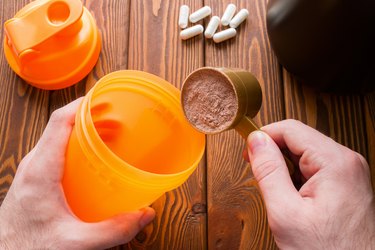
If you've started drinking a smoothie in the morning or after working out, you might be wondering if you should use water or milk for a protein shake. They both serve the purpose of adding liquid to the mix, so the decision really comes down to personal preference and dietary needs.
Tip
The decision to use milk or water for protein shakes depends on a variety of factors including desired calorie content, taste, dietary needs and convenience.
Video of the Day
Protein Powder With Water
The easiest and most affordable way to make a protein shake is with water. In fact, the recipe on most product labels uses water as the liquid. Although, many also say you can use water or milk for a protein shake.
Video of the Day
You can use protein powder with water in a blender, a shaker bottle or if you don't mind a few clumps, simply add it to a regular water bottle and stir or shake until most of the clumps are dissolved.
A basic protein shake with water recipe will likely include the following ingredients:
- 1 scoop of protein powder
- 1 cup of cold water
- 1 to 1 1/2 cups of frozen fruit (if using fresh fruit, add 1 cup of ice)
- To make: Add all ingredients to a blender and blend on smoothie speed or low to medium until desired consistency is reached.
When on the go, some people opt for a shaker bottle to make protein shakes. This is a plastic, reusable water bottles with a lid that has a metal blender ball in the bottle that mixes the ingredients when you shake the bottle.
If you're using one of these to mix protein powder with water, consider using cold water from the refrigerator, especially if you like a cool drink. You can add ice to keep it chilled, but it will not add to the consistency of the shake.
Protein Powder With Milk
For a shake with a creamier texture or to add calories and other nutrients such as calcium and vitamin D, you can add milk to a protein shake. According to the USDA, 1 cup of low-fat milk has 102 calories, 8.2 grams of protein, 2.3 grams of fat and 12.2 grams of carbohydrates.
Provided you're not a vegetarian, lactose intolerant or have a food allergy, using milk in a protein shake is a great way to increase the amount of protein and boost your intake of calcium. In fact, the Academy of Nutrition and Dietetics recommends drinking an 8-ounce glass of milk with a meal to boost calcium in your diet.
To take advantage of these benefits, simply swap out the recommended amount of water in a protein shake with water recipe and use milk instead. When choosing the fat content, the Academy does point out that fat-free and low-fat milk have the same amount of calcium as whole milk.
Athletes and avid exercisers may be interested to know that a December 2012 review published in the Journal of the International Society of Sports Nutrition found that the timing of milk consumption, more specifically, post-workout, had a positive impact on increases in lean body mass, strength, hypertrophy and decreases in body fat. Through the studies, the authors also found that milk proteins are superior to soy proteins in promoting lean body mass and muscle mass development.
Protein Shake for Weight Loss
Many commercial diet plans require the use of meal replacement shakes with protein. Several will use whey protein with milk or water for weight loss. Whey protein is a by-product of the cheese-making process, according to the Mayo Clinic. Along with casein protein, whey is one of the two main proteins in milk.
According to the USDA, 1 scoop of whey protein powder isolate has 103 calories, 0 grams of fat, 8 grams of carbohydrates, and approximately 18 grams of protein. It's important to note that these figures are based on a generic protein powder. For exact nutrition information, refer to the product label on the protein powder you're using.
Replacing meals with shakes containing protein powder with water may help reduce calories and lead to weight loss. But eventually, solid foods will be part of your diet again, and you could end up putting those pounds back on if you haven't made other dietary changes.
That said, using whey protein with milk or water for weight loss is an option as long as the majority of your calories comes from solid food. For example, consider swapping out one of your snacks, preferably around your workout time, for a protein shake.
- Journal of the International Society of Sports Nutrition: "Protein Timing and Its Effects on Muscular Hypertrophy and Strength in Individuals Engaged in Weight-Training"
- The Mayo Clinic: "Whey Protein"
- U.S. Department of Agriculture, MyFood Data: "Whey Protein"
- The Mayo Clinic: "Protein ShakesL Good for Weight Loss?"
- U.S. Department of Agriculture, FoodData Central: "Milk, low fat (1%)"
- Academy of Nutrition and Dietetics: "Calcium"